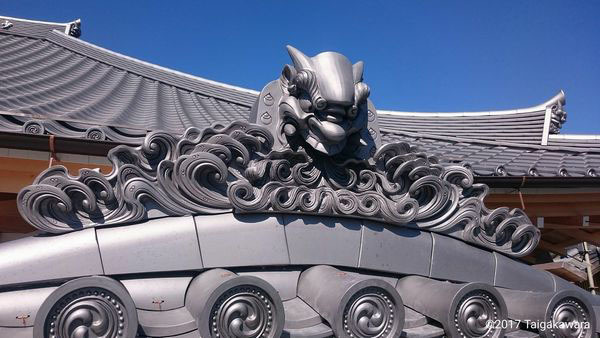
- Ceramic
- Aichi
Sanshu Onigawara Crafts Sanshu onigawara kogeihin
Guardian gods on the rooftops of Japan
A refined roof tile made with traditional techniques with a history of more than three hundred years
Description
What is Sanshu Onigawara Crafts ?
Sanshu Onigawara Crafts, called Sanshu Onigawara Kougeihin in Japanese, are a traditional craft mainly produced in Hekinan, Anjo and Takahama of Aichi Prefecture. The name "Sanshu" comes from the old name of this region in Aichi. The region had high quality clay suitable for roof tiles, and as blended clay, glaze for pottery and ceramics were also produced in this area, the roof tile industry developed.
The raw material used for porcelain clay is Mikawa clay, mountain soil and levigated clay. By baking at a high temperature of approximately 1,150 degrees Celsius (2,127 Fahrenheit), the roof tile becomes highly durable, and comes out in a unique oxidized silver color.
While maintaining the tradition, the colors, shapes and functions of the roof tiles continue to evolve, and now approximately 70 percent of clay roof tiles in Japan are produced in this region.
History

The production of roof tiles in the Nishi-Mikawa region (central part of Aichi), increased as a local industry in and after 1720 when Yoshimune TOKUGAWA promoted tile roofing,
The roof tile industry developed, as they had an abundant amount of material for roof tiles with Yahagi River carrying high quality clay from Mt. Sanage, plus being close to the sea, they were able to transport roof tiles to Edo (current Tokyo) by ship.
Onigawara, Japanese gargoyle roof tiles, were originally set on the roofs as amulets, protective charms, or symbols of prosperity and wealth, but their purpose has changed with the times. They are currently used as decorations or luck charms for every day use such as ornaments for alcoves or entrance halls.
National treasures and important cultural property are also being repaired by the Sanshu Onigawara craftsmen.
General Production Process

- 1. Design drawing
A precise design pattern is drawn, taking into consideration the shrinkage when baked in the kiln.
- 2. Marking
Using a pattern, the design is drawn on the clay and then cut with a sickle to form the front part of the onigawara.
- 3. Attaching The side parts are attached to the front part. The joint surfaces are scratched with a tool called kakiyaburi and are softened by applying water with a brush. The same process is done on the back side.
- 4. Shaping
Clouds and other designed parts are attached on the surface, shaping the onigawara as a whole.
- 5. Finishing
When the clay dries and hardens to just the right hardness, a spatula is used for finishing.
- 6. Drying
The roof tile is dried slowly and carefully from the center for a month in a windless room. The dryness is adjusted with a cloth and the roof tile is turned over from time to time during this period.
- 7. Baking
The roof tile is baked at a high temperature of approximately 1,150 degrees Celsius (2,066 Fahrenheit). It takes about two to three months to complete a large onigawara.
See more Ceramic
- Imari ware/Arita ware
- Hasami ware
- Kutani ware
- Mashiko ware
- Shigaraki ware
- Bizen ware
- Hagi ware
- Koishiwara ware
- Mino ware
- Tobe ware
- Tokoname ware
- Karatsu ware
- Kasama ware
- Satsuma ware
- Iga ware
- Mikawachi ware
- Agano ware
- Otani ware
- Obori-soma ware
- Tsuboya ware
- Aizu-hongo ware
- Shodai ware
- Echizen ware
- Akazu ware
- Tamba-tachikui ware
- Yokkaichi-banko ware
- Izushi ware
- Kyo ware/Kiyomizu ware
- Iwami ware
- Amakusa ceramics
- Seto-sometsuke ware
- Sanshu Onigawara Crafts
See items made in Aichi
- Tokoname ware
- Akazu ware
- Toyohashi brushes
- Nagoya textiles
- Nagoya Buddhist altar
- Owari Cloisonné
- Arimatsu tie-dyeing
- Mikawa Buddhist altar
- Seto-sometsuke ware
- Nagoya kimono-dyeing
- Nagoya traditional paulownia chest
- Okazaki stonemasonry
- Nagoya Sekku Kazari
- Owari Buddhist altar equipment
- Sanshu Onigawara Crafts































































































































































































































































































